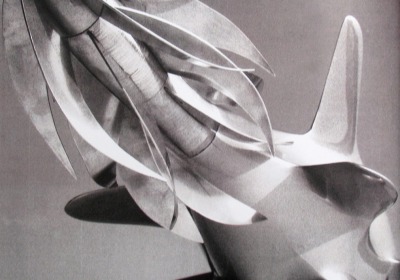Luigi Colani - Translating Nature
Wed, 13 Jun 2007One of the most influential designers of the past half-century, Luigi Colani, is the subject of an exhibition at the Design Museum in London. With a career spanning almost six decades, Colani has applied his unique design style to produce cars, trucks, boats, aircraft, ceramics and consumer goods, as well as creating futuristic concepts for as-yet unrealized transport systems and architecture. There are Colani tea pots, mineral water bottles and sun glasses, but much of his work remains in the form of dream-like models or photographic montages. While operating firmly outside the mainstream of the automotive design industry, Colani's work has had a huge influence on automotive designers. CDN met with Colani in London, where he explained his design philosophy.
Born Lutz Colani in Berlin in 1928, his father was a movie set designer from Switzerland, his mother an actress from Poland. Colani studied sculpture at the Akademie der Kuenste, Berlin, and moved to Paris in 1947 to study aerodynamics at Universite de Paris-Sorbonne. Lutz became 'Luigi' with his 1952 newspaper feature on a jet-powered motorbike, under the brand name 'LuCo'. At the 1954 Geneva Motor Show he presented a sports coupe based on the Fiat 1100, for which he won the Golden Rose prize. He later won the 'Golden Shoe' fashion prize for his 'elevator' high-heel shoe design.
Colani explained to CDN that in his early studies he was strongly influenced by the world of classical sculpture, and that he "frantically tried to mix both high technology and beauty", to mix function and form in a way found in nature... "I respect nature".
A prime characteristic of Colani's design work is rounded, organic forms, which he terms 'biodynamic'. He is famous for avoiding straight lines in his work: "Everything on the microcosmic as well as the macroscopic plane is made up of curves... I can only obey the laws of nature."
The exhibition 'Translating Nature' includes Colani's studies of sea life, and animations that mix aquatic life with Colani's own 'bioform' designs. Colani explains that his father advised him as a child: "Try to go in the garden and look at the plants and animals, and try to imagine, all the problems were solved over millions of years". Colani sketches a cross-section through a bird's wing, explaining how all the aeronautics design answers are already there, shaped by evolution, from variable wing geometry to wing leading-edge slats.
Colani presented an ideal vehicle aerodynamic form with his 'C-Form' concept in 1968, a vehicle where the whole body forms an inverted wing. The concept was featured in Stern magazine, and has influenced a generation of student designers with its architecture of four wheel-pods suspending a central cabin form. The 1982 'Le Mans 82' sports coupe and BMW 'M2' were studies that while somewhat baroque, defined a unique form language seen years later in vehicles such as the Corvette Indy and Porsche 959.
Colani's aircraft designs have ranged from lightweight personal aircraft to huge heavy-lift flying wings and re-usable spacecraft, all photographed by Colani in a distinctive style that presents scale models as if full-size, with meticulously modeled sets and tiny figures to complete the illusion. Colani has also been involved in production aircraft design, his 1976 Fanliner the first plastic sports airplane with a Wankel rotary engine.
Colani moved to Japan in 1982, where he was named 'Designer of the Year' in 1984. "I stayed 10 years in Japan, with the aim to help them extrapolate from their own culture, instead of trying to copy Europe". He designed the groundbreaking 1986 Canon T90 camera, which applied bio-forms to previously angular camera design, and featured a prominent forward-set hand-grip with ergonomic controls that has become a standard architecture for most cameras since.
Colani comments that his vacation time while in Japan was spent diving, studying the forms of undersea life. "What an institute!" he exclaims.
Continues...
By Brett Patterson



